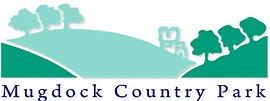Mugdock Country Park
    | |
|---|---|
| Type | Country park |
| Location | East Dunbartonshire/Stirlingshire, Scotland |
| Nearest city | Glasgow |
| Area | 260 ha (642 acres) |
| Status | Open |
Mugdock Country Park is a country park and historical site located partly in East Dunbartonshire and partly in Stirling, in the former county of Stirlingshire, Scotland. It is around 10 miles (16 kilometres) north of Glasgow, next to Milngavie (from which the park is easily accessible), and covers an area of 260 hectares (642 acres).
The park includes the remains of the 14th-century Mugdock Castle, stronghold of the Grahams of Montrose, and the ruins of the 19th-century Craigend Castle, a Gothic Revival mansion and former zoo. The park has a moot hill and gallowhill, historical reminders of the baronial feudal right, held by lairds, of "pit and gallows". Also located in the park are the remains of numerous anti-aircraft trenches, which were established during World War II as part of the Clyde Basin anti-aircraft defense system.
The park was also the home of the Mugstock Music Festival, at which performers have included Emma Pollock, Dodgy and Beats Antique.
Natural features include the Allander Water, Mugdock Loch and Drumclog Muir, all of which provide popular walking and cycling routes with tourists. Visitor facilities include a visitor centre and cafe in the former Craigend Castle stable block, and a garden centre and restaurant in the walled garden.
The park is served by the Mugdock and East Dunbartonshire Countryside Ranger Service.
The West Highland Way, a linear long distance footpath between Milngavie and Fort William, passes through the outer areas of the park alongside the local Clyde Coastal Path.
Close again to the country park is Milngavie water treatment works, another popular walking and tourist attraction. It is situated just south of Mugdock and connects to the park via Drumclog Moor.
References
- "Mugdock Country Park". VisitScotland. Retrieved 22 April 2019.
- "Exploring The Castles & History of Mugdock Country Park". www.lifeofgibbers.com. Archived from the original on September 27, 2020. Retrieved 6 March 2020.
- "Mugdock Castle". Castles for Battles. Retrieved 7 March 2020.
- "Criagend Castle". britainirelandcastles.com. Retrieved 7 March 2020.
- "Moot Hill". Mugdock Country Park. Retrieved 7 March 2020.
- "Our Built Heritage The Gallowhill". Mugdock Country Park. Retrieved 7 March 2020.
- "The dark history of Scotland's drowning pools". The Scotsman. 18 March 2016. Retrieved 7 March 2020.
- Historic Environment Scotland. "Mugdock Wood, Battery (105603)". Canmore. Retrieved 7 March 2020.
- Nan Spowart (18 July 2016). "Emma Pollock headlines this year's MugStock Festival". The National. Retrieved 7 March 2020.
- "Hundreds expected to flock to MugStock as festival gets under way". Evening Times. 7 August 2015. Retrieved 7 March 2020.
- "5 River Allander Circuit" (PDF). Bearsden and Milngavie Ramblers. Retrieved 7 March 2020.
- "Mugdock Loch". Gazetteer for Scotland. Retrieved 7 March 2020.
- ^ "Mugdock Country Park & Milngavie Reservoirs". Ramblers Association. Retrieved 7 March 2020.
- "Mugdock Country Park". Visit Scotland. Retrieved 7 March 2020.
- "Countryside Ranger Service - Practical Nature Conservation". Mugdock Country Park. Retrieved 7 March 2020.
- "Milngavie to Drymen". West Highland Way Management Group. Retrieved 7 March 2020.
External links
- Mugdock Country Park on Canmore, Historic Environment Scotland.
- Video footage of the Moot Hill, Gallows Knowe and Drowning Pit
See also
55°58′N 4°19′W / 55.967°N 4.317°W / 55.967; -4.317
Categories: